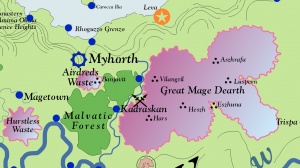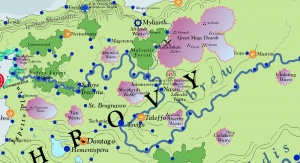Difference between revisions of "Throe Wastes"
Trismegistus (talk | contribs) m (→See Also) |
Trismegistus (talk | contribs) m (→Sources) |
||
| Line 19: | Line 19: | ||
=Sources= | =Sources= | ||
*[[Catalogue of the Witchlands]], [[Griffain Vedachier of Magetown]], 2643; list and description of the Throe Wastes of [[Throvy]]; [[Throvian Language]] | *[[Catalogue of the Witchlands]], [[Griffain Vedachier of Magetown]], 2643; list and description of the Throe Wastes of [[Throvy]]; [[Throvian Language]] | ||
| + | *[[Islands of Desolation]], [[Zalia Talinibli]], 2629; author's account of her exploration of the periphery of several Throe Wastes; [[Tassan Language]] | ||
*[[Legends of the Witchlands]], [[Vastvar Igoriaco]], 2691 | *[[Legends of the Witchlands]], [[Vastvar Igoriaco]], 2691 | ||
*[[Lost Cities of the Witchlands]], [[Griffain Vedachier of Magetown]], 2646 | *[[Lost Cities of the Witchlands]], [[Griffain Vedachier of Magetown]], 2646 | ||
Revision as of 00:52, 2 January 2020
The horrendous wars and chaos magics of the Middle Ages created vast zones of warped magic in Throvy and in the great plains east of the present-day Aurician Empire. These vast zones of unpredictable and vacuous magic lie for the most part south and west of the great Thybdis River. The greatest Throe Waste is called the Great Mage Dearth and covers about a third of the province of Alascundy. Other Throe Wastes of great size are the Ulcanosto Waste, the Van Waste, the Shepherds Waste, the Durstnot Waste, the Hurstless Waste, and Airdred's Waste[1]. Most of the witchlands as they are also known in Throvy were created during the Anarch Wars, 2166 to 2224. Throvian folklore fills in many gaps which scholars are reluctant to endorse with certainty[2].
Conditions of a Throe Waste
A typical throe waste is stripped of most vegetation with a remnant of sand or dirt and clumps of stunted plants. Few animals will enter or live in a throe waste and even most birds will fly around it. The barren state of a throe waste is harmless compared to its magical corruption and imbalance. Most often, spellcasters find it impossible to cast a spell of any significance, for the panstream runs nearly dry. Less frequently, magical storms of intense power ravage the throe waste, wreaking havoc on persons, creatures, and titancraft which are sensitive to magical energy. Even everyday living creatures will suffer debilitating sickness and malnutrition after a few days of exposure to a throe waste. The Aurician Empire in cooperation with local provincial authorities has set up multilingual signs outside of the Throe Wastes warning would-be visitors to turn back.
Blackfire Hills
The Blackfire Hills stretch across the common frontier of Ferruvicar and the Aurician Province of Frantigoria. These small mountains share properties similar to the Throe Wastes, but the magic vacuum is generally less severe.
Ghost Towns

In addition to the dissipation and contamination of nature, several towns were consumed by the devastation of the chaos magic, including Banjavit, Camptephir, Vilangril, Hars, Heszh, Eszhuna, Aszhrafa, Hufsa, Khaha, Johar, and Secruba[3]. The Lost Cities are a continual lure for the adventurous and foolhardy. Most explorers die and the few who survive suffer debilitating sickness the rest of their lives. Authorities admonish visitors not to enter the throe wastes.
Creatures of the Throe Wastes
It is thought that only simple creatures such as insects and animalcules can withstand the corrupt and vacuous magical environment of the throe wastes. However, the vivid tales of bards and storytells continually report the presence of undead horrors such as the bacchabund, burrowfiends, bonelouts, cryptcreepers, and cryptilians. These entities are believed in popular folklore to have been created when these lands first fell victim to the horrifying magics of the divinities of Chaos during the Middle Ages of Chaos.
Sources
- Catalogue of the Witchlands, Griffain Vedachier of Magetown, 2643; list and description of the Throe Wastes of Throvy; Throvian Language
- Islands of Desolation, Zalia Talinibli, 2629; author's account of her exploration of the periphery of several Throe Wastes; Tassan Language
- Legends of the Witchlands, Vastvar Igoriaco, 2691
- Lost Cities of the Witchlands, Griffain Vedachier of Magetown, 2646
Notes
See Also
| This article is a stub. It requires further development by the creator. |
